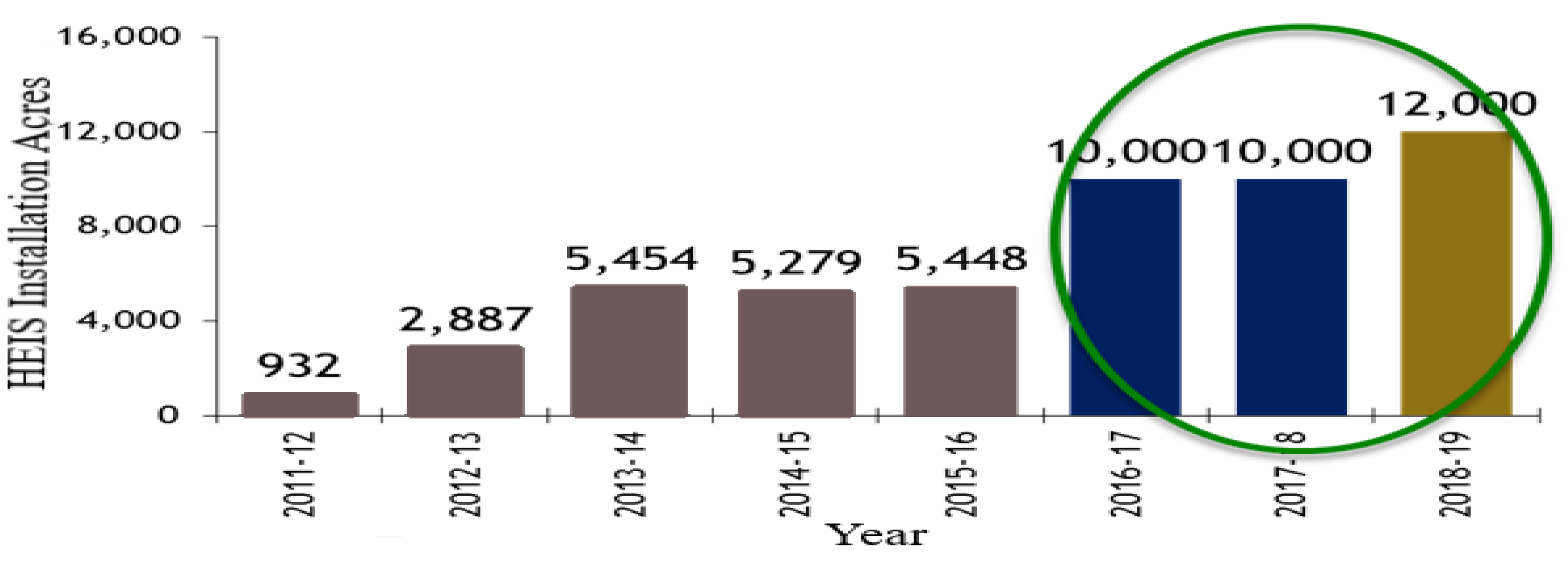Socioeconomic and Climatic Impacts of Photovoltaic Systems Operating High-Efficiency Irrigation Systems: A Case Study of the Government Subsidy Scheme for Climate-Smart Agriculture in Punjab, Pakistan †
Abstract
:1. Introduction
2. Materials and Methods
- (i)
- Agriculture farms using photovoltaic powered HEIS.
- (ii)
- Agriculture farms using electricity or diesel powered HEIS.
- (iii)
- Agriculture farmers who use flood irrigation as a method of irrigation were used as a baseline.
3. Results and Discussion
3.1. PV-Powered HEIS Adoptability
3.2. Savings in Energy Cost
3.3. Reduction in CO2 Emissions
3.4. Water Savings in HEIS
4. Conclusions
Conflicts of Interest
References
- Planning and Development Department Government of the Punjab. Punjab Growth Strategy 2018: Accelerating Economic Growth and Improving Social Outcomes. 2015. Available online: https://www.theigc.org/wp-content/uploads/2015/04/Punjab-Growth-Strategy-2018-Full-report.pdf (accessed on 3 July 2021).
- Agriculture Statistics of Pakistan. Agriculture Marketing Information Service (AMIS). Directorate of Agriculture (Economics & Marketing) Punjab, Lahore. 2017. Available online: http://www.amis.pk/agristatistics/statistics.aspx (accessed on 11 July 2021).
- Schneider, U.A.; Kumar, P. Greenhouse gas mitigation through agriculture. Choices (N. Y.) 2008, 23, 19–23. [Google Scholar]
- Siddiqi, A.; Wescoat, J.L., Jr. Energy use in large-scale irrigated agriculture in the Punjab province of Pakistan. Water Int. 2013, 38, 571–586. [Google Scholar] [CrossRef]
- Qureshi, A.L.; Lashari, B.K.; Kori, S.M.; Lashari, G.A. Hydro-salinity behavior of shallow groundwater aquifer underlain by salty groundwater in Sindh Pakistan. In Proceedings of the Fifteenth International Water Technology Conference, IWTC-15, Alexandria, Egypt, 31 March–2 April 2011; pp. 1–15. [Google Scholar]
- Kim, Y.; Evans, R.G. Software design for wireless sensor-based site-specific irrigation. Comput. Electron. Agric. 2009, 66, 159–165. [Google Scholar] [CrossRef]
- Blagbrough, V. Looking Back: The Long-Term Impacts of Water and Sanitation Projects; WaterAid: London, UK, 2001. [Google Scholar]
- Foster, R.; Ghassemi, M. Solar Energy: Renewable Energy and the Environment; CRC Press, Taylor & Francis Group: Boca Raton, FL, USA, 2009; pp. 32–40. [Google Scholar]
- Ahmad, S.; Ali, I. Feasibility of Solar Powered Pumping Systems for Deep Tube Wells in Pakistan, Managing Natural Resources for Sustaining Future Agriculture; Research Briefs, Natural Resources Division, Pakistan Agricultural Research Council: Islamabad, Pakistan, 2011; Volume 3. [Google Scholar]
- Shouman, E.R.; El-Shenawy, E.T.; Badr, M.A. Economics analysis of diesel and solar water pumping with case study water pumping for irrigation in Egypt. Int. J. Appl. Eng. Res. 2016, 11, 950–954. [Google Scholar]
- Cuadros, F.; López-Rodrıguez, F.; Marcos, A.; Coello, J. A procedure to size solar-powered irrigation (photoirrigation) schemes. Solar Energy 2004, 76, 465–473. [Google Scholar] [CrossRef]
- Mahmoud, E.; El-Nather, H. Renewable energy and sustainable developments in Egypt: Photovoltaic water pumping in remote areas. Appl. Energy 2003, 74, 141–147. [Google Scholar] [CrossRef]
- Tamoor, M.; ZakaUllah, P.; Mobeen, M.; Ans-Zaka, M. Solar Powered Automated Irrigation System in Rural Area and their Socioeconomic and Environmental Impact. Int. J. Sustain. Energy Environ. Res. 2021, 10, 17–28. [Google Scholar]


Publisher’s Note: MDPI stays neutral with regard to jurisdictional claims in published maps and institutional affiliations. |
© 2021 by the authors. Licensee MDPI, Basel, Switzerland. This article is an open access article distributed under the terms and conditions of the Creative Commons Attribution (CC BY) license (https://creativecommons.org/licenses/by/4.0/).
Share and Cite
Raza, F.; Tamoor, M.; Miran, S. Socioeconomic and Climatic Impacts of Photovoltaic Systems Operating High-Efficiency Irrigation Systems: A Case Study of the Government Subsidy Scheme for Climate-Smart Agriculture in Punjab, Pakistan. Eng. Proc. 2021, 12, 36. https://doi.org/10.3390/engproc2021012036
Raza F, Tamoor M, Miran S. Socioeconomic and Climatic Impacts of Photovoltaic Systems Operating High-Efficiency Irrigation Systems: A Case Study of the Government Subsidy Scheme for Climate-Smart Agriculture in Punjab, Pakistan. Engineering Proceedings. 2021; 12(1):36. https://doi.org/10.3390/engproc2021012036
Chicago/Turabian StyleRaza, Faakhar, Muhammad Tamoor, and Sajjad Miran. 2021. "Socioeconomic and Climatic Impacts of Photovoltaic Systems Operating High-Efficiency Irrigation Systems: A Case Study of the Government Subsidy Scheme for Climate-Smart Agriculture in Punjab, Pakistan" Engineering Proceedings 12, no. 1: 36. https://doi.org/10.3390/engproc2021012036
APA StyleRaza, F., Tamoor, M., & Miran, S. (2021). Socioeconomic and Climatic Impacts of Photovoltaic Systems Operating High-Efficiency Irrigation Systems: A Case Study of the Government Subsidy Scheme for Climate-Smart Agriculture in Punjab, Pakistan. Engineering Proceedings, 12(1), 36. https://doi.org/10.3390/engproc2021012036





